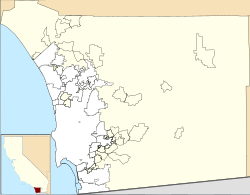This article needs additional citations for verification .(March 2013) |
Edgemoor Farm Dairy Barn | |
 | |
| Location | 9200 N Magnolia Magnolia, Santee, California |
|---|---|
| Coordinates | 32°50′36″N116°58′9″W / 32.84333°N 116.96917°W |
| Built | 1913 |
| NRHP reference No. | 85001065 |
| Added to NRHP | May 16, 1985 [1] |
Edgemoor Farm Dairy Farm was built as part of a dairy farm in 1913 in Santee, California. Edgemoor was part of a Spanish land grant to Maria Antonio Estudillo who married Miguel de Pedrorena, a native of Madrid. By the 1850s, through a variety of ways, individuals obtained portions of the grant and began to farm. Walter Hamlin Dupee purchased Edgemoor Farm in 1913 and built it into a national award-winning dairy farm, and early tourist attraction.
Contents
- As a home for the aged and indigent
- As a geriatric hospital
- Historic Registered Site
- Santee Historical Society Museum
- References
- External links
Such was his prominence that the Guernsey Breeders Association in 1921 called his place "the foremost authority and breeder in the U.S.", having given the most grand champions at this ranch founded by John and Walter Dupee. Dupee said, "I am interested in pure breeding stock, modern equipment, and scientific methods, which I place at the disposal of all dairymen". A series of personal setbacks and problems brought Dupee to sell Edgemoor to Godfrey L. Strobeck.


